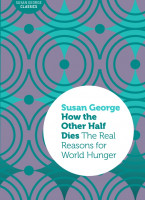Susan George and contemporary anticapitalist struggles within and against the global food system
Topics
This year, 2021, the global community of food sovereignty activists is celebrating what is deemed as the 25th year anniversary of food sovereignty – as it protests against a corporate-captured UN Food System Summit (UNFSS) this September 2021. The global food system remains front and center in international political debates, as working people struggle to survive during this ongoing pandemic while a few corporate food giants continue to make huge profits. The struggle to dismantle the unjust, unsustainable industrial food system while constructing alternatives around food sovereignty is at the core of contemporary anti-capitalist struggles.

Events, movements and individuals.
As we mobilize in the trenches today, it is important to reflect on key events, movements and individuals that and who have made important contributions to the global struggles. Events and movements are easy to identify.
We know how much La Via Campesina has played a critical role in forging a multi-class, global movement in the struggle against the global food system and in framing and constructing an alternative, food sovereignty. La Via Campesina and its affiliates are not the only movements that made important contributions in this struggle front. There are many overlapping movements, most of which are not as famous and recognized as La Via Campesina: fishers’ movements, farmworkers’ movements, indigenous peoples’ movements, food workers’ associations, and so on.
Key events are noted, and regularly remembered and celebrated. The autonomous civil society mobilizations parallel to the FAO-anchored World Food Summit of 1996 is one of the key moments in the history of contemporary struggles against the industrial food system and in the construction of food sovereignty. There is a consensus that food sovereignty as a concept and political project has been inaugurated in Rome in November 1996 at the World Food Summit. Twenty-five years after, in 2021, it seems that the UN has not advanced in terms of charting a path towards an alternative food system, but rather has gotten stuck in corporate control. Indeed, the UN Food System Summit of 2021 aims to set up a new UN architecture that would roll back the gains of food sovereignty-inspired initiatives since 1996 and trail-blaze a corporate-driven path.
Key individuals who played key roles in these struggles are less recognized compared to events and movements, perhaps because of the emphasis on political struggles and movements and institutions than on individuals. But the role played by individual actors does matter, especially when seen not as something separate from movements and events, and is important to note as well.
World Food Summit 1974.
1996 to 2021 is often remembered as the period when food sovereignty was launched and gained significant traction and momentum. But it is equally important to look further back in history – or at least the period immediately preceding – that is, 1974-1996 -- because this was when the fundamental building blocks that made 1996 possible were conceived and constructed. A good grasp of the contribution of this period to the rise of food sovereignty movements is crucial for shaping a future trajectory where food sovereignty struggles are organically embedded in broader anticapitalist struggles.
The basic building blocks in the construction of the 1996 event did not just appear out of nowhere. They came from somewhere, and not only from the initial list of national agrarian movements that comprised La Via Campesina, although their role was crucial. The efforts of international movements, radical institutions and scholar-activists, although not as plentiful as they are today, secured the foundation for internationalist anti-capitalist struggles to emerge on the global food systems front. The role played by a handful of radical international scholar-activist research institutions, such as the Institute for Policy Studies (IPS), Food First, and the Transnational Institute (TNI) – and key individuals in these institutions, such as Joe Collins, Frankie Moore Lappe, Walden Bello, and Susan George – were pivotal, not only during the World Food Summit in 1974 – but throughout the 1974-1990s period.
 More specifically, some of the key classic works of Susan George in the 1970s and early 1980s on the politics of the food system, namely, How the Other Half Dies, Feeding the Few: Corporate control of food, and a massively powerful illustrated Food for Beginners, helped frame subsequent radical agendas and the style and method of articulating these: well-informed, fully committed to political movements and actions, anti-capitalist, broadly accessible in style – and timeless in their relevance: the official agendas in the World Food Summit in 1996, and the agendas in the UN Food System Summit and protests against it today are all fundamentally cast in Susan’s earlier classic works.
More specifically, some of the key classic works of Susan George in the 1970s and early 1980s on the politics of the food system, namely, How the Other Half Dies, Feeding the Few: Corporate control of food, and a massively powerful illustrated Food for Beginners, helped frame subsequent radical agendas and the style and method of articulating these: well-informed, fully committed to political movements and actions, anti-capitalist, broadly accessible in style – and timeless in their relevance: the official agendas in the World Food Summit in 1996, and the agendas in the UN Food System Summit and protests against it today are all fundamentally cast in Susan’s earlier classic works.
Below are some random selections from her classics works of the 1970s and early 1980s:
On the global food system: the cost of profits. This global food system is efficient, but only if you’re willing to measure all efficiency in terms of profit and not count any of the costs that do not show up on a corporate balance sheet. Some costs that don’t appear on such ledgers are: human costs (… the slow disintegration of rural centers as more and more residents – not just farmers but shopkeepers, doctors or teachers – move away for lack of livelihood.); nutritional and health costs (…Lots of sugar & fats and yummy additives & marbled, grain-fed beef, MMMMM just the thing for heart disease, diabetes, and a host of other maladies.); environmental costs (two bushels of top soil are currently lost in producing every bushel of corn… So many pesticides are used that they sometimes create pest outbreaks because they destroy natural predators… water is mined like it’s going out of style…); energy costs (energy use in this food system tripled between 1940 and 1970); genetic costs (just a handful of varieties of every species makes up the bulk of the crop: four Canadian breadwheats account for 75% of all production, 2 kinds of peas for 96% of the US harvest, 6 kinds of corn cover 70% of the vast US corn belt. In these circumstances, if a blight hits, a huge part of the crop can be zapped…The Academy of Sciences puts it more elegantly: ‘US crops are impressively uniform genetically and impressively vulnerable’); and financial costs ([overcharges] to farmers and consumers.
And it’s fragile. So why is it tolerated? The one word answer is Profit. The two word answer is More Profit, for a very small minority of super-farmers and a handful or oligopolistic companies.
What to do? Strengthen the Weak and Weaken the Strong. And don’t try to do it all alone. Working with other people is important. So is starting from where you are. Try first to understand how concentrated, minority control over your own area’s food system affects your life and the lives of people in your community. Develop an eye and a nose for the way power expresses itself close to home as one tool for better understanding oppression abroad… None of us is called to take up every aspect of the struggle… According to your circumstances, location, particular talents, etc., you can choose an area of concentration and a compatible group to concentrate with. You may decide the place to work is at the home front. Pressure there is vital if we are to move towards a more environment-sustaining, people-oriented food system. Reaching that goal will involve all those interests whose profits would be reduced or wiped by change, however beneficial that change might be for the majority. Weakening links in our present food system at home – like TNCs – will also weaken their influence in the dominated countries. The [Global South] does have food production problems, but the way to solve them is not by copying Western methods… There are no models or recipes. There are local environments, local skills and local social arrangements.
As early as 1979, Susan had also sounded the alarm about the use of satellite technology and data and information mining in order to deepen and expand the imperialist and corporate control of the global food system. In a way, Susan’s analysis on what is today called ‘digital agriculture’ was four decades ahead of time! Just as for sure in COP26 one of the key contentious issues would be the fact that the industrial food system, which contributes up to a third of the GHG emissions, does not include all costs in producing industrial food, at least not the environmental, nutritional and health, energy, and genetic costs. And here again, when we read How the Other Half Dies published nearly 50 years ago, Feeding the Few, and the brilliant early 1980s illustrated Food for Beginners, Susan has so early on and very sharply and powerfully articulated these issues.
Susan was not the first to articulate radical views on the food system for there were classic issues and debates before the 1970s. Nor was she the only one to have articulated these during the period of the 1970s, for there were others like Joe Collins, Frankie Moore Lappe, Walden Bello, and others. But she was among the few during this period who articulated these issues in a way that comes closest to the content focus, style and method, as well as political direction of the subsequent period led by La Via Campesina and its close allies (movements and scholar-activists). She was among the few who articulated these unapologetically in the context of scholar-activism in which collective action and institutional instruments of struggles such as movements and organizations are front and center (in her case, IPS and TNI). She was among the few ones that emphasized a multi-class character of movements and cross-class alliances that would prove to be so central to any political projects today. She was among the few who articulated these issues in a truly, deeply and consistently internationalist fashion. She was among the few who articulated these issues within a categorically anti-capitalist stance that is nuanced and pluralist, in a sense that would later be articulated by Erik Olin Wright as ideal types of anti-capitalist struggles of the 21st century: smashing capitalism, taming capitalism, resisting capitalism, and escaping capitalism – where the challenge is not to pick one or the other, but how to combine these various types in order to erode capitalism.
Susan’s classic works on the food system always end by reminding the readers that she is writing this or that work as a scholar-activist of the Transnational Institute (TNI), and that therefore, it is important to confront the political questions of: what is to be done? And then she always goes into the details of practical politics as to who, where, when, how, why of collective action – and always firmly anchored in the tradition of being well-informed, and so stressing the role of research, as well as of being multi-class, pluralist, anti-capitalist and internationalist. This is why Susan’s work has been so deeply influential then, and why it still is today.


